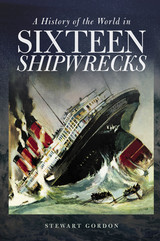247 scholarly books by University Press of New England and 6
start with H
247 scholarly books by University Press of New England and 6
247 scholarly books by University Press of New England
6 start with H start with H
6 start with H start with H

“Here, There and Everywhere”
The Foreign Politics of American Popular Culture
Edited by Reinhold Wagnleitner and Elaine Tyler May
University Press of New England, 2000
American popular culture is everywhere. All over the world, kids wear Levis, radios blare rap songs, television stations broadcast American programs, and Hollywood movies draw huge audiences. Does this massive "Americanization" of the globe represent some sinister form of cultural imperialism? Alternatively, do audiences and consumers in the importing countries accept American movies, music, and television programs because they match local trends and desires? Do receiving communities transform these products to fit their own needs, to the point where they are no longer "American" but in fact have become indigenous? And who is in charge of all of this, anyway? Is it Wall Street, Madison Avenue, the Pentagon, the CIA, or Hollywood? Is it, at least partly, local economic and political elites in the receiving countries? Or is it simply "the people," nationalities be damned? These are the questions at the heart of the essays collected in "Here, There and Everywhere." Essays by 23 authors from 14 countries cover topics from Japan to Spain, Nigeria to Russia, and from West Germany to East Germany (a distance that seemed to be further than travelling to the moon, yet was covered by rock 'n' roll most easily, despite the wall). In five sections, they examine the historical background, the impact of Hollywood, the power of American popular music from jazz to rock 'n' roll and rap, and the popularity of as well as resistance to American popular culture in particular countries.
[more]

A History of Boston in 50 Artifacts
Joseph M. Bagley
University Press of New England, 2016
History is right under our feet; we just need to dig a little to find it. Though not the most popular construction project, Boston’s Big Dig has contributed more to our understanding and appreciation of the city’s archaeological history than any other recent event. Joseph M. Bagley, city archaeologist of Boston, uncovers a fascinating hodgepodge of history—from ancient fishing grounds to Jazz Age red-light districts—that will surprise and delight even longtime residents. Each artifact is shown in full color and accompanied by description of the item’s significance to its site location and the larger history of the city. From cannonballs to drinking cups and from ancient spears to chinaware, A History of Boston in 50 Artifacts offers a unique and accessible introduction to Boston’s history and physical culture while revealing the ways objects can offer a tantalizing entrée into our past. Packed with vivid descriptions and art, this lively history of Boston will appeal to all manner of readers, locals and visitors alike.
[more]

A History of the World in Sixteen Shipwrecks
Stewart Gordon
University Press of New England, 2017
Stories of disasters at sea, whether about Roman triremes, the treasure fleet of the Spanish Main, or great transatlantic ocean liners, fire the imagination as little else can. From the historical sinkings of the Titanic and the Lusitania to the recent capsizing of a Mediterranean cruise ship, the study of shipwrecks also makes for a new and very different understanding of world history. A History of the World in Sixteen Shipwrecks explores the age-old, immensely hazardous, persistently romantic, and ongoing process of moving people and goods across the seven seas. In recounting the stories of ships and the people who made and sailed them, from the earliest craft plying the ancient Nile to the Exxon Valdez, Stewart Gordon argues that the gradual integration of mainly local and separate maritime domains into fewer, larger, and more interdependent regions offers a unique perspective on world history. Gordon draws a number of provocative conclusions from his study, among them that the European “Age of Exploration” as a singular event is simply a myth: over the millennia, many cultures, east and west, have explored far-flung maritime worlds, and technologies of shipbuilding and navigation have been among the main drivers of science and exploration throughout history. In a series of compelling narratives, A History of the World in Sixteen Shipwrecks shows that the development of institutions and technologies that made the terrifying oceans familiar and turned unknown seas into well-traveled sea-lanes matters profoundly in our modern world.
[more]

Hot Hands, Draft Hype, and DiMaggio's Streak
Debunking America's Favorite Sports Myths
Sheldon Hirsch
University Press of New England, 2017
In sports there are lies, damned lies, and statistics. Joe DiMaggio’s fifty-six-game hitting streak was magical. The three-point shot is an essential part of NBA basketball. Babe Ruth shouldn’t have attempted to steal second base in the ninth inning of the 1926 World Series. Scientist and researcher Sheldon Hirsch has taken a decidedly unorthodox approach to sports history. He looks at myths, legends, conventional wisdom, shibboleths, and firm convictions of all kinds that sports lovers hold to be true, and demonstrates how analysis of facts and figures disproves what tradition—and sportswriters—would have us believe. Divided into three parts, on baseball, basketball, and football, Hot Hands, Draft Hype, and DiMaggio’s Streak contains enough clear-sightedness and shocking conclusions to delight any sports lover.
[more]

A House Divided
Orthodoxy and Schism in Nineteenth-Century Central European Jewry
Jacob Katz
University Press of New England, 2005
Eminent social historian Jacob Katz examines the rise and transformation of Jewish communal leadership in Central Europe. It is a story of fragmentation and polarization that sheds light on the tensions within the 19th-century Jewish community in Central Europe as it struggled to respond to the promises and perils of modernization.
[more]

The House on Ipswich Marsh
Exploring the Natural History of New England
William Sargent
University Press of New England, 2015
In 2003, Bill Sargent bought a big pink house in Ipswich, Massachusetts. His home sits on what is known as the Great Marsh, a fascinating patch of wetland shared by Massachusetts and New Hampshire. Sargent received a grant to study some of the rare and endangered ground-nesting birds that inhabit the public land adjacent to his property. Ipswich Marsh is about these birds, but much else as well. Organized by the seasons of the year, The House on Ipswich Marsh features Sargent’s trademark interplay of information about the natural world, ecology, and politics. In “Spring,” the reader learns about the geological history of the Marsh; the migration patterns of bobolinks; the courtship flights of woodcocks; ticks and Lyme disease; the mating of horseshoe crabs and the underwater arrival of zooplankton, fish eggs, and moon jellyfish. “Summer” introduces plate tectonics and glaciers; sea level rise and glacial rebound; diving at night among lobsters and stone crabs; a day on Crane’s Beach; and a bike trip on Argilla Road. “Autumn” illuminates fishing; the natural and cultural history of Hog Island; harvest time on Appelton Farm; and a Native American Thanksgiving. “Winter” describes the formation of dunes and sandbars; the mating behavior of seals; coyote hunting deer at night; and a late-winter blizzard in which Sargent spies a red-tailed hawk, waiting, like the author, for the return of spring.
[more]
READERS
Browse our collection.
PUBLISHERS
See BiblioVault's publisher services.
STUDENT SERVICES
Files for college accessibility offices.
UChicago Accessibility Resources
home | accessibility | search | about | contact us
BiblioVault ® 2001 - 2024
The University of Chicago Press









